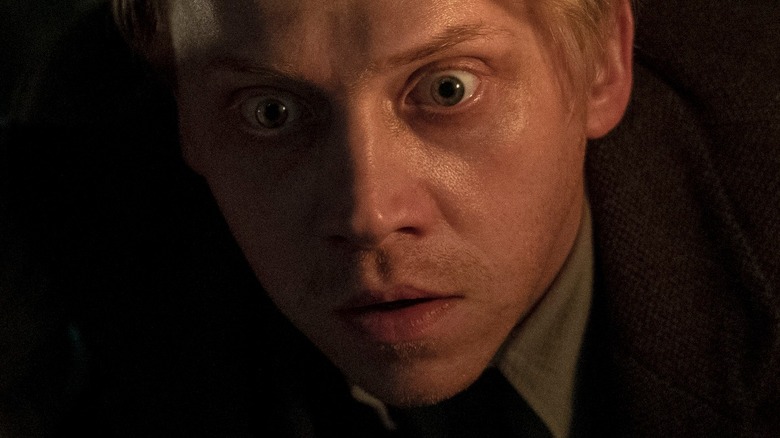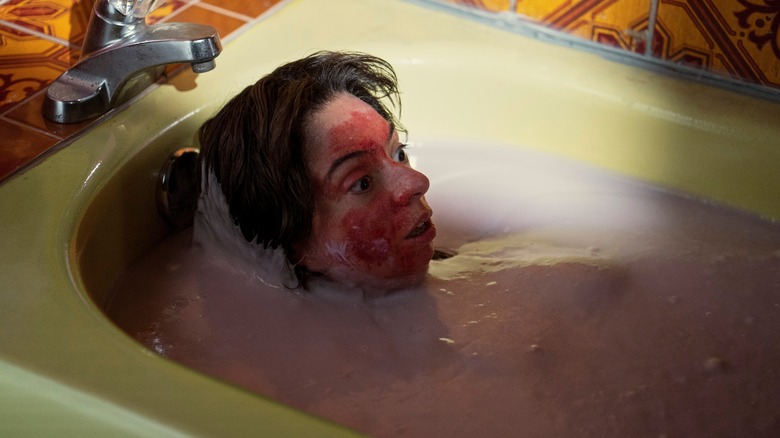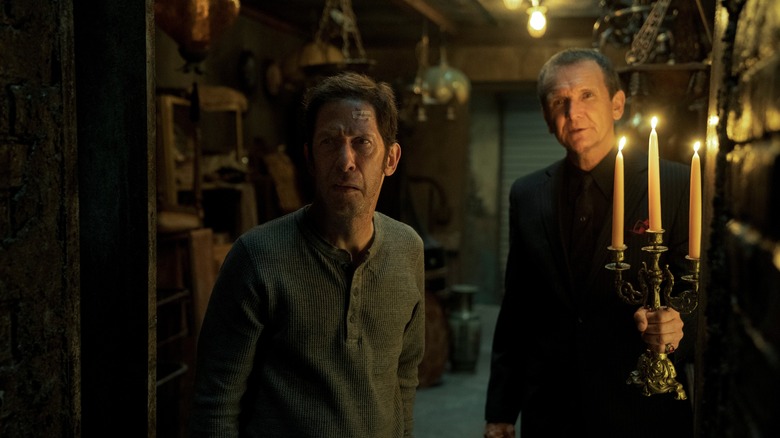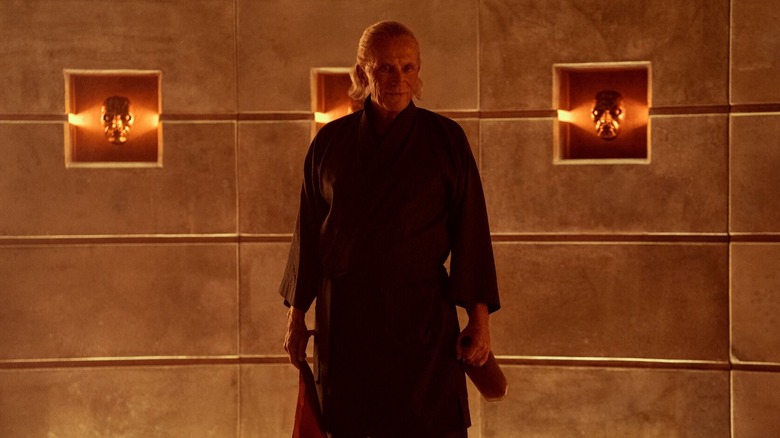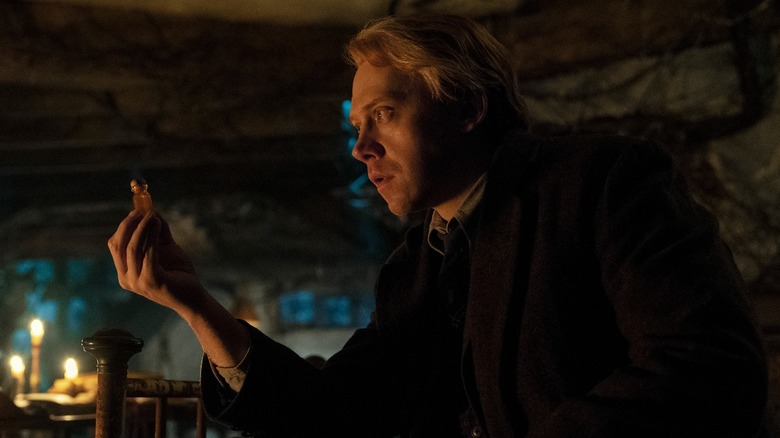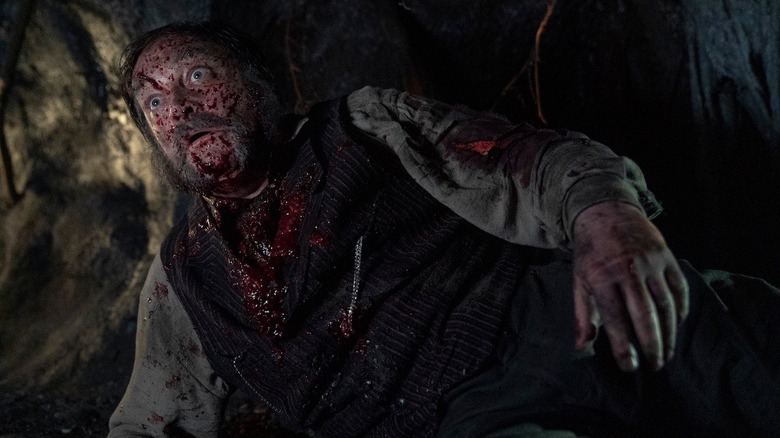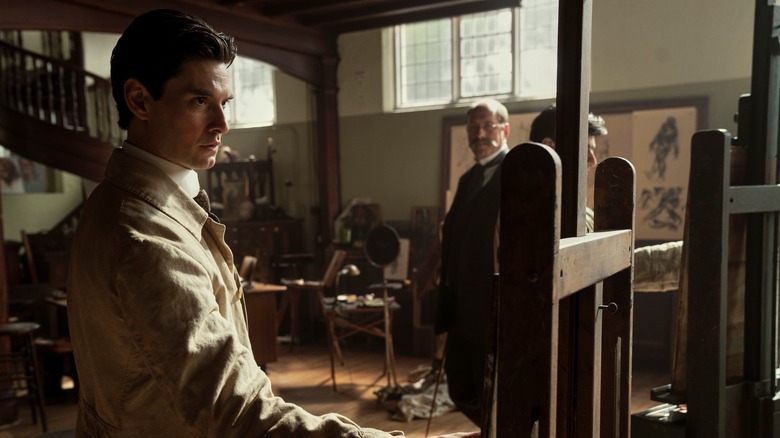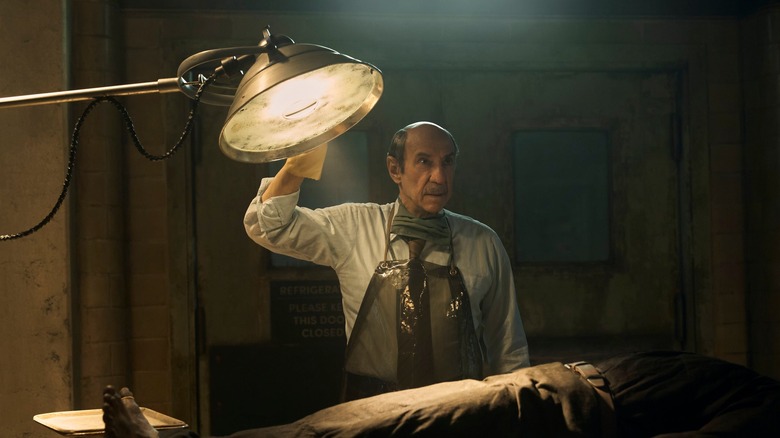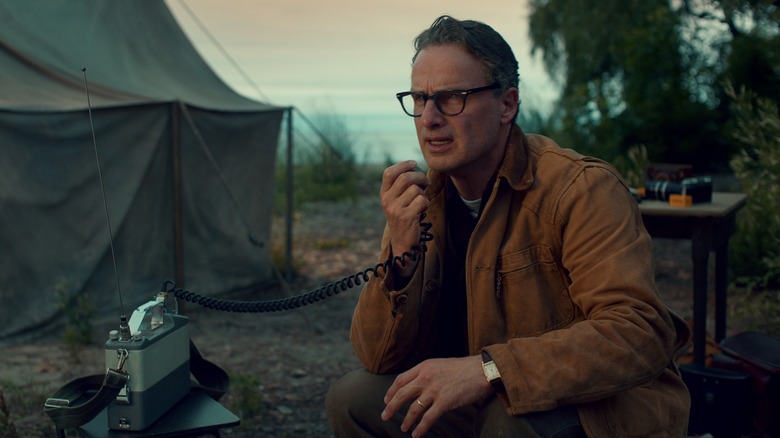Every Episode Of Guillermo Del Toro's Cabinet Of Curiosities, Ranked
There's a reason why Guillermo del Toro is often considered to be one of the definitive names in modern horror. Since his feature length debut with 1993's "Cronos," del Toro has created a name for himself as a master of the genre. Throughout his career, he has crafted films featuring addictive vampires, forest-dwelling witches, mythical fairy tale creatures, and an endless variety of monsters, demons, and spirits.
With his Netflix series, "Guillermo del Toro's Cabinet of Curiosities," del Toro ventures deeper into the heart of horror, exploring stories and subgenres that interest him. These range from bizarre original stories to adaptations of classic H.P. Lovecraft tales. Directed by several different filmmakers, including Jennifer Kent ("The Babadook"), Vincenzo Natali ("Cube"), and Panos Cosmatos ("Mandy"), every episode of "Cabinet of Curiosities" feels entirely distinct. However, as unique as each entry is, they are all tied into del Toro's love for all things horror. The result is a series lauded by critics, cementing del Toro's place as an icon of horror.
As great as "Cabinet of Curiosities" is as a whole, there's no denying that certain entries in the series are better than others, featuring either stronger writing, better pacing, or superior performances compared to some other episodes. Here is every episode of the first season of "Guillermo del Toro's Cabinet of Curiosities " ranked from worst to best.
8. The Outside
The suburbs of Illinois are the setting of the episode "The Outside," directed by Ana Lily Amirpour, best known for her critically acclaimed vampire flick "A Girl Walks Home Alone at Night." It's the story of socially awkward bank clerk Stacey (Kate Micucci), who has trouble fitting in with her more trend-savvy co-workers. Resolving to make a change, Stacey begins to regularly lather her face and body in an expensive beauty lotion. The more she douses herself in the lotion, though, the more her mind and body begin to suffer adverse effects.
In many ways, "The Outside" feels like the crime series "Fargo," if "Fargo" had decided to delve more deeply into horror. Star Kate Micucci and her onscreen husband Martin Starr both speak with monotone Midwestern accents, arguing about whether Stacey's qualities are a weakness or one of her most positive attributes. Starr is great fun to watch, but it's Micucci's Stacey who steals every scene she's in. She seems to come across as two different performers in one, beginning the episode as a quirky bank teller and ending it as a shell of her former self. It's not only a physical transformation but an emotional one, perfectly encapsulated by Miccuci's grounded performance.
However, aside from some top-notch acting, "The Outside" doesn't have much to offer viewers, existing as arguably the worst episode in the series. More creepy than genuinely scary, it's a blend between slasher and body horror, though not a particularly memorable one. The message it delivers about the dangers of conformity and vanity is important, but the episode could have been executed better.
7. Lot 36
Nick (Tim Blake Nelson) is a disgruntled Vietnam War veteran facing significant financial problems. Owing money to some dangerous people, Nick successfully bids on a vacant storage lot in the hope it will yield some valuable items. After discovering some strange objects inside the lot, Nick contacts an occult expert (Sebastian Roché), who tells Nick of the lot owner's insidious past.
The shortest episode in "Cabinet of Curiosities," Guillermo Navarro's "Lot 36" also has the least amount of substance out of any entry in the series. Unevenly paced, it builds a sense of mystery that is ineptly handled in the final five minutes or so. If the episode had spent more time on the background surrounding the mysterious lot Nick purchases, it might've been slightly better. Sadly, in its current state, its conclusion screeches to an unsatisfying halt, petering out just when things really start getting interesting.
Regardless, the episode does have some stronger qualities. The performances of Nelson and Roché mean "Lot 36" is still worth watching. In the second act of the episode, both characters share some splendid dialogue together, well balanced by Nelson's dismissive nature and Roché's more academic view of the supernatural. "Nelson is phenomenal, playing all the bitterness and selfishness of his fascist brainwashing but keeping enough tiny cracks of humanity to remain compelling, even when he inevitably comes across a storage unit with truly horrific contents," said The Guardian.
6. The Viewing
In the late 1970s, four people — a psychic (Michael Therriault), a novelist (Steve Agee), a musician (Eric André), and an astrophysicist (Charlyne Yi) — are invited to the remote, luxurious home of the mysterious billionaire Lionel Lassiter (Peter Weller). As the night unfolds, Lassiter presents his guests with an unusual artifact, an object seemingly not of this world.
Helmed by Panos Cosmatos, "The Viewing" is relatively light on scares in comparison to the other episodes of "Cabinet of Curiosities," with most of them coming in the final ten minutes. However, this entry is a lesson in atmospheric, nostalgic horror, with the majority of the episode composed primarily of '80s-esque visuals and synth-heavy music. With past works like the Nicolas Cage-led revenge film "Mandy," Cosmatos has proven himself capable of capturing a unique tone unlike any other filmmaker working in horror today. Channeling that creative strength, "The Viewing" comes across as the ideal successor to "Mandy," resembling the film in more ways than one, from the surreal imagery to the psychedelic narrative.
As commendable as the tone of the episode is, the sparse scares will no doubt make it a bit tedious for some. Indeed, while most critics praised the superior look of the episode, they also saw its horror elements as being far weaker than the other installments. "Hardcore horror fans may be turned off by an entry that's heavy on vibes and light on frights, but it's silly to be upset when the vibes are this striking," said IndieWire.
5. Dreams in the Witch House
As a boy, Walter Gilman (Rupert Grint) sees his twin sister's recently departed spirit whisked away to a spectral netherworld. Decades later, Gilman — now an adult paranormal investigator — searches for ways to reach the "other side." Finding an entrance into the nether-realm, Gilman's plans to contact his deceased sister are soon complicated when a long-dead witch plans on using him to return to the land of mortals.
From a narrative standpoint, "Dreams in the Witch House" is the lesser of the two Lovecraft adaptations in "Cabinet of Curiosities." Perhaps the source material isn't as engaging or easy to adapt as "Pickman's Model," but the overall pacing of the episode leaves much to be desired. That being said, Rupert Grint makes for a great Lovecraftian actor, displaying open-eyed wonder, desperation, and fear whenever he seems on the trail of finding his long-departed twin. The former "Harry Potter" star shines in the role — the fact that we don't see Walter as a grown-up Ron Weasley is a testament to his performance.
One of the best things about "Dreams in the Witch House" (which is helmed by Catherine Hardwicke, the director of "Twilight") is that the set design and atmosphere give it an engrossing, pulpy feel. Unfortunately, from a horror perspective, the episode is average at best, containing not nearly enough scares to unsettle audience members. However, in terms of general intrigue, it's a solid installment that will keep you guessing until the end credits are rolling.
4. Graveyard Rats
Graveyard caretaker Masson (David Hewlett) begins supplementing his income by robbing the graves of the recently deceased in 1930s Salem. Pressured into paying back some substantial debts, Masson ventures into the grave of a wealthy shipping merchant. He quickly becomes lost in a sophisticated maze of underground tunnels, fending for himself against the giant, ravenous rats that inhabit the cemetery.
It's a scary set up, but the thing that makes "Graveyard Rats" so enjoyable is the gripping lead performance. As Masson, the criminally underrated Hewlett shines bright, portraying all the conflicting complexities of his character. In one scene, he's feverishly praying to God, lamenting about his lot in life and ruminating about a day where he'll rise above his squalid living conditions. In the next, he's desperately digging through the earth with the wide-eyed look of a maniac, driven by greed, self-interest, and the promise of loot. It's an acting tour de force by Hewlett, helping establish Masson as both cartoonishly animated and somehow disturbingly realistic in his motivations. Director Vincenzo Natali was full of praise for his star man, commending him for working so well in such claustrophobic conditions.
Based on Henry Kuttner's 1936 short story of the same name, "Graveyard Rats" is one of the highlights of the series. The effects behind the giant, subterranean rats make for some disturbing results, with the episode coming across like a more believable Universal Classic Monsters film. The only thing that might have made it better is if it was shot in black and white to really sell the old school horror aspect of the episode.
3. Pickman's Model
Set in early 20th century Massachusetts, "Pickman's Model" follows Richard Upton Pickman (Crispin Glover), an enigmatic yet brilliant artist whose hellish paintings delight and confound anyone who views them. Driven by curiosity, Pickman's talented schoolmate Will Thurber (Ben Barnes) begins to wonder about Pickman's inspiration, only for the subjects of Pickman's pieces to begin appearing in his personal life.
Taken from H.P. Lovecraft's beloved horror story of the same name, "Pickman's Model" is nothing short of a wondrous adaptation. In it, director Keith Thomas effortlessly captures the ambiguous world of Lovecraft's early 1900s New England. Dreamlike in its atmosphere and Gothic in its settings, it shuffles between a hallucinatory, spellbound quality and the utterly horrific imagery presented through Pickman's paintings. Opposite each other, Glover and Barnes turn in some excellent performances, their dated Massachusetts accents adding a layer of authenticity to the episode, not unlike the thick accents used in the similarly Lovecraftian film "The Lighthouse."
Compared to "Dreams in the Witch House," "Pickman's Model" more fully captures the surreal nature of Lovecraft's stories. This episode is fun, disturbing, and incredibly dark, a welcome contribution to the anthology. Critics lauded the plot and the overall vibe, with Greg Wheeler of The Review Geek writing: "The idea of madness and art working hand in hand is not a new concept, but the way it's portrayed here is given a really nice Gothic horror edge."
2. The Autopsy
In the late 1970s, the terminally ill physician Dr. Carl Winters (F. Murray Abraham) is asked to perform a series of autopsies on victims of a mining explosion. As he conducts his medical examinations, Winters begins to find unexplained medical phenomena around some of the victims' bodies, believing one of them to not even be human at all.
The most science fiction-heavy episode of "Cabinet of Curiosities," "The Autopsy" is led by a powerhouse performance from F. Murray Abraham. Having long come to terms with the fact that the end is near for him, he spends what little time he has left frankly assessing the fleeting nature of life and all the mysteries of existence that will go unanswered. His calm existentialism is a strong part of the episode, with similarly great performances from Glynn Turman as a world-weary small-town sheriff and Luke Roberts as an alien trapped in the rotting flesh of a miner. In terms of its subject matter, "The Autopsy" also veers heavily into the body horror subgenre, often focusing on explicit imagery that can be hard for some (if not most) to handle.
At its heart, the story that unfolds within "The Autopsy" is pure excellence. Director David Prior spends the first half of the episode constructing a palpable mystery through flashbacks, with the second act largely devoted to the drama taking place inside Winters' medical room. Wonderfully broken up into two absorbing halves, the finished product is a sci-fi story as horrifying as "The Thing," "Alien," or any of David Cronenberg's body horror movies.
1. The Murmuring
Nancy and Edgar Bradley (Essie Davis and Andrew Lincoln) are a married pair of ornithologists trying to recover from a family tragedy. Traveling to a house on a remote island for their research, the couple soon begin to experience paranormal events that seem connected to their shared loss.
Helmed by director Jennifer Kent, "The Murmuring" has all the shades of Kent's previous work on "The Babadook." Like that film, "The Murmuring" relies more on psychological horror than on random jump scares. Framed around Nancy's point of view, the audience is never quite sure if what they're seeing and hearing is real or just a product of her imagination. Even more interesting than the potential ghosts of the episode is the emotional unease the couple feel, with the spirits Nancy encounters likely serving as manifestations of her repressed grief.
Davis and Lincoln are both phenomenal, portraying characters clearly unable to move past their trauma. Retreating inwards, you can see how splintered their marriage has become since the tragedy, with Edgar's attempts at rekindling their relationship regularly rebuked by Nancy. You're not aware of it at the start of the episode, but the moment they step foot on that island is the moment that will forever decide their marriage.
It's an episode that packs quite a punch, mixing horror with genuine human emotion in a way that Kent masterfully conveys. This is without a doubt the best episode of the series. "Kent has thought it all through, and when 'The Murmuring' ends, it is moving, and satisfying, in a way that the rest of the series hasn't reached for," said The New York Times.
